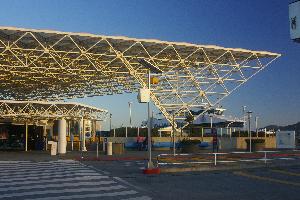
Larkspur Ferry Terminal
I guess you don't really consider the trip to have begun until you're buckled into your seat (with your tray table stowed and your seat back upright) and the engines rev up for a trip down the runway... but I've always considered the Marin Ferry Terminal a really cool structure, so it's here at the beginning of the trip.
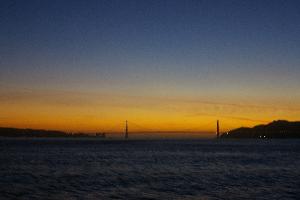
Colorful Sunset
While crossing the bay, the sun setting past the Golden Gate is a "good omen."
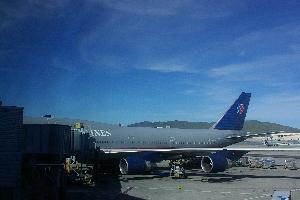
Big Ol' Jet Airliner
Most of us know what a jet looks like, and those that need to know already know what I look like, so for me to stand in front of a jet seems a bit pointless. Still, the page looks a little drab without at least one picture, so... ;)
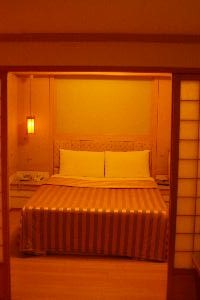
Weary Wanderer's Bed
Ah... Taipei at last. Good night!
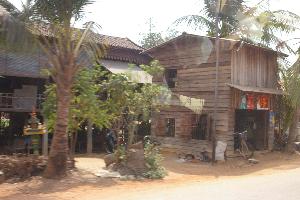
Unchanged by Time
If you're willing to overlook the odd anachronism -- a bicycle here, a transistor radio there, logo-emblazoned clothing, and so on -- you can readily imagine that this is how people might have lived here for hundreds of years. This is a house along the road to Tonle Sap.
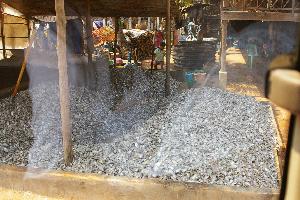
Fishes-es-es
This catch is bound for the bottle: fish sauce, a pungent condiment found in Cambodian, Vietnamese, and Thai cooking.
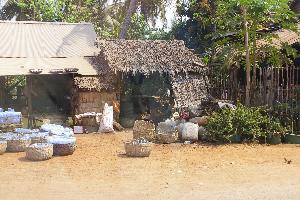
Bottling plant
All manner of bottles are pressed into fish-sauce duty; here the empties are being dried prior to their being filled.
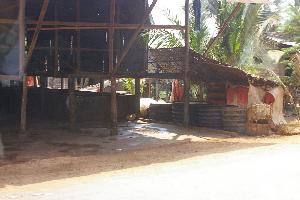
Pungent Vats
The culinary brew is allowed to ferment in these wooden vats, a common sight (and smell!) along the side of the road...
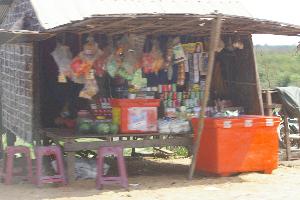
Commerce Abounds
If there's one way to characterize the Cambodian people, it is as "entrepreneurs." This is not to say that every home is a tourist trap -- that's just not the case -- but there's a thriving economy. Not constrained by the idea that a store is three walls and a sheet of plate glass, it's hard to go more than a hundred feet an not find somebody seeling something. In this case, refreshments to passing locals.
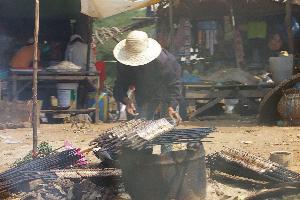
Smoked fish
Here a woman turns a flat of fish that are being smoked...
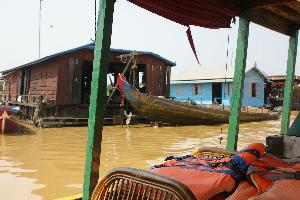
Floating Village
Tonle Sap Lake is the largest lake in south-east Asia, and that doesn't take into account the fact that depending on the season, it changes size considerably. Being at the heart of Cambodia, it is also at the heart of Cambodian life, and there are many that call the lake (and tributaries) their home. Many of these homes float, and move with the shoreline through the seasons.
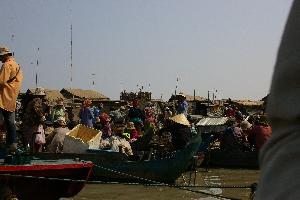
Floating Market
Here's an open-air market long the Siem Reap tributary...
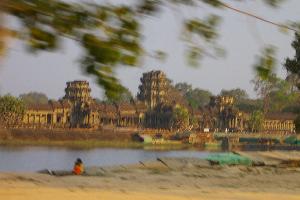
Angkor What?
Hmmm... that looks familiar, but we're dashing by to "make the sunset" at another location, so looks like this glimpse is all we'll get... for now...
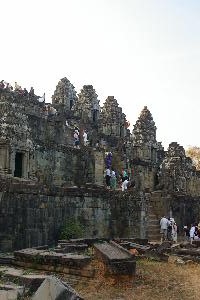
Solar Pilgrimage
It's the end of the first day, and we've just climbed a short, steep grade up the hill to this specimen of 9th Century work, Phnom Bakheng. It's also the "designated" sunset spot, and had become quite crowded. I was a little concerned that the entire Angkor site would be overrun by tourists like ants at a picnic, but happily it wouldn't be. It's just that most of the people visiting on any given day become concentrated at this site as sunset approaches.
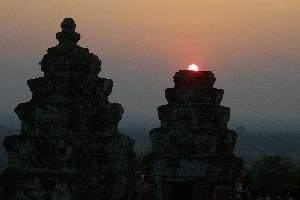
Topping Off the Day
Once the sun crept closer to the western horizon, the sky put on a wonderful show, bathing Phnom Bakheng in a warm saffron glow. And later still, it offered this little visual treat. But once the sun is gone, it's a mass exodus back to the waiting busses, scooters, and bicycles at the foot of the hill.
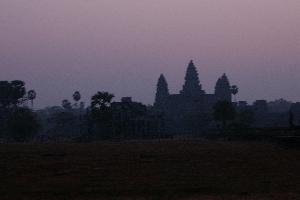
Angkor Silhouette
Playing with exposure time, I was able to get this shot while the horizon was still dark. (I'm saving others for later posting... ;)
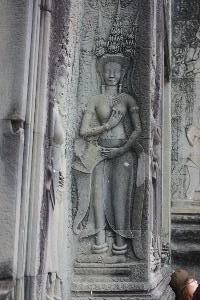
Abundant Apsaras
One motif that is common to nearly all Angkor art -- regardless of the period in which it was built -- is that of the Apsara, mythological nymphs which sprung venus-like into existence in the Khmer creation story.
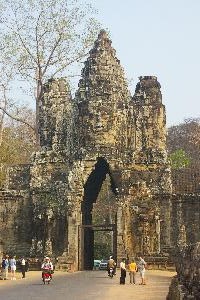
South Gate
Later that morning, we headed to the south gate of the Angkor Thom complex... just a short drive north of Angkor Wat, and stone's throw from the first day's sunset at Phnom Bakheng. This is one of the many well-traveled parts of the complex, and it's hard to get into the moment with busses coughing out diesel smoke as they head through the gate.
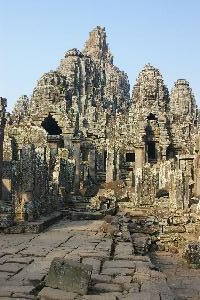
The Bayon
This incredibly picturesque temple was built in the late 12th century, and depicts an architectural and artistic style unique to its period. It's also a lot of fun to explore, with many nooks and hidey-holes and multiple terraces. One can only imagine what it looked like in its day...
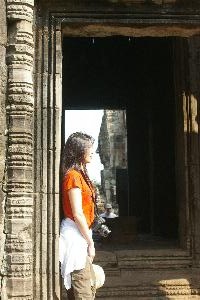
Nose to Nose
The tour-guides have a figured out all the "kodak moments" to be found in the ruins, and The Bayon has its share... as we can see, it's possible to go nose-to-nose with a Buddha. (Or was that Shiva, hmmm... how quickly we forget these things!)
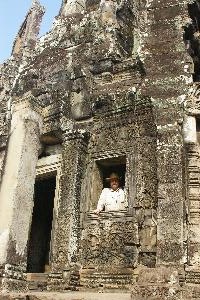
Another Lawn-Gnome Moment
Yup, this is one of those obligatory "yes, mom, I'll have somebody take my picture" pictures. I guess it's not so much for a mother to ask... ;)
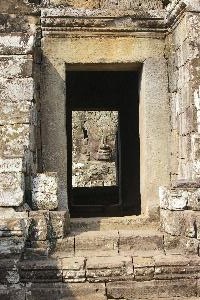
Buddha in the Window
A room with a view... of the adjacent cupola, this small shrine affords is another one of those oft-recommended kodak moments.
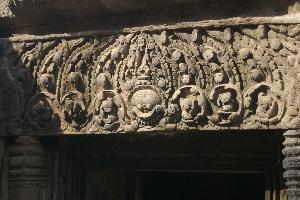
800-year detail
One of the things that remains so amazing is the state in which much of these ruins are in. Bear in mind that the exteriors of nearly everything here is sandstone, which is relatively soft and subject to erosion. But somehow, the detail remains crisp and well-defined, as is shown in this lintel.
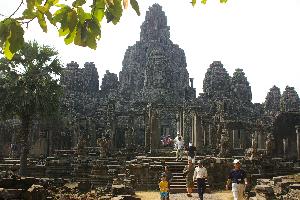
Bayon North
The outermost perimeter of this multi-tiered structure has taken the most serious damage, as can be seen by the outer wall being little more than a few pillars and tumbled stones.
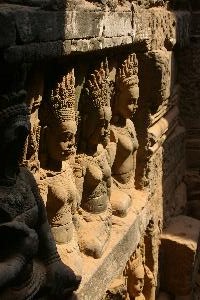
Apsara Line
Here, in a part of the Terrace of Elephants, some exquisitely-preserved Apsaras bask in the late morning sun.
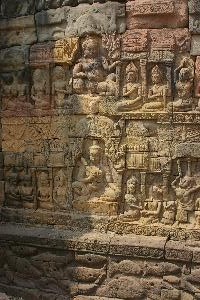
Naughty and Nice
Here, the deity (Shiva?) is depicted with his two wives, each with a list of names and deeds. The one on the left (appropriately shaded) is the list of those who have done evil, and on the right is the list of those that have done good. These lists of who's been naught and who'se been nice sounds vaguely familiar. ;)
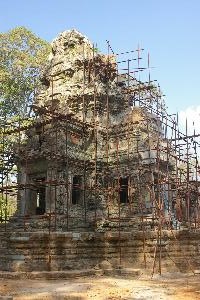
Restoration Efforts
There are many countries that have been actively participating in the restoration of Angkor Wat: France and Japan seem to have contributed the most, with other countries, such as Germany and China also adding to process. By the way, not all the temples you see today are as they were found. Several had collapsed and were subsequently restored, and others have actually been completely disassembled and reassembled within the last century. Here, a building from Chao Say Tevoda is being given a new lease on life.
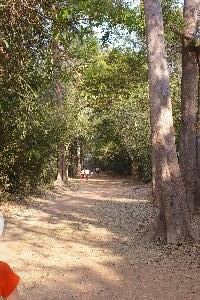
Mysterious Jungle Path
Ahhh... this, to me, evokes the spirit that I've always associated with Angkor Wat. In fact, for the longest time, I assumed that all of Angkor Wat looked like this little site, Ta Prohm, and it wasn't until much later that I learned that most of it had actually been restored. Here at Ta Prohm, though, the jungle still reigns.
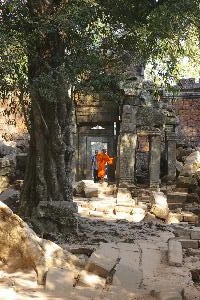
Saffron Robes
Another mistaken rarity was the odd Buddhist monk lingering amidst the desolate ruins... but in actuality, they are quite common nearly everywhere. They do add a wonderful splash of color, too.
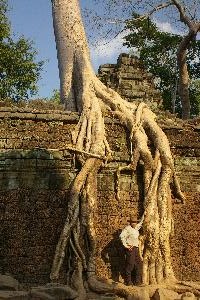
Jungle takes Root
While most of the other sites are being restored to as close to original state as is possible, Ta Prohm remains refreshingly unrestored, including these invasive trees which have over time so incorporated themselves into the stones that their removal is all but impossible. In fact, in many places, the roots are all that are still holding the walls together. Yeah, another Lawn-Gnome moment.
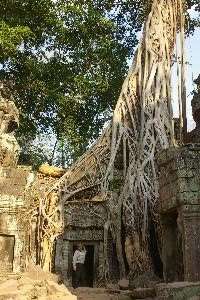
Wooden Irony
The Angkor Wat area, in spite of being badly damaged by the ravages of time and the encroaching jungle, oddly owes its continued existence to the same jungle, which kept most plunderers, blunderers, and all manner of more destructive forces from leveling these pieces of world heritage. One need only imagine whether the Buddha statues in Afghanistan would have missed the Taliban's vandalism if they, too, had been shrouded in the thick green carpet.
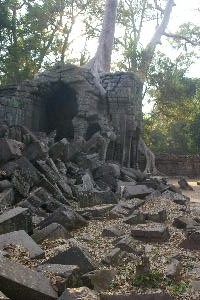
Hold Things Together
Just an example of how the tree, while having invaded the stone structure, has actually helped hold it together. The adjacent wall has already crumbled.
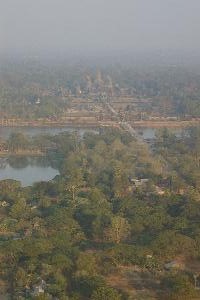
Angkor Wat Aerial View
One of the ways to see the complex is by hot-air baloon, a tethered contraption that rises to about 150 meters (about 500 feet) above the ground. The moat, wall, and inner complex of Angkor Wat are visible in the distance.
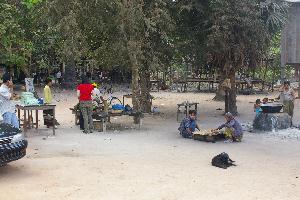
Making Sugar
On the way to Banteay Srei we stopped at one family's house as they were making sugar from palm fruits. From right to left, a kettle is cooking the syrupy mixture down, while two men lay out circular palm-leaf rings to act as molds; a table holds raw ingredients ready for the next batch, and finally, finished product is stacked on a table beside the road, ready for sale.
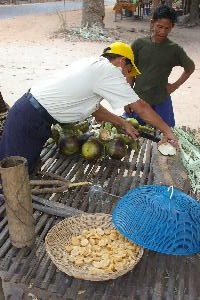
The Ingredients
Palm Sugar comes both from from the fruit of the female tree, and the large finger-like blossom clusters of the male tree. Here our guide cuts away the fruit husk to reveal gelatinous fruit and a reservoir of slightly sweet juice. The bamboo canister in the foreground holds the extract from the male flowers. Both will be reduced over fire.
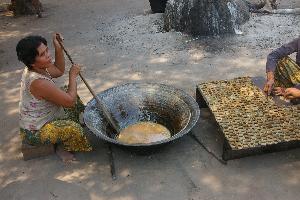
Cooling the Boil
After the water has been boiled off, the remaining syrup, lightly caramelized, is stirred to cool before being placed into the molds.
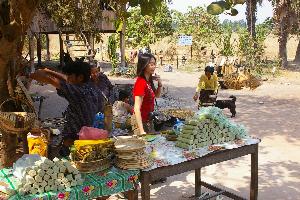
Finished Product
The finished products, inch-diameter disks, are stacked in palm-leaf tubes. You'll see them set out for sale on tables along the road throughout the countryside.
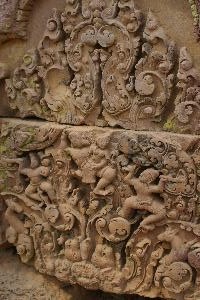
Exquisite Detail
The carvings at Banteay Srei are perhaps the most detailed, and compared to many other sites this one comes across as "delicate". It's a bit off the beaten path, but the visual treat of ornate stonework makes the trip worthwhile.
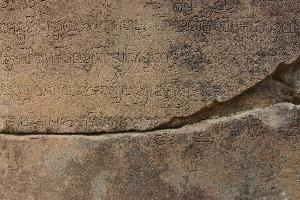
Ancient Writings
I don't know how many people can still read this, but after a millenium, this sanskrit is still legible. (I guess you could call that "archive quality"... ;)
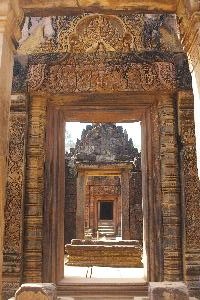
Hall of Doors
Architects would get a kick out of studying Angkor Wat, Banteay Srei, and Prea Kahn, each of which transitions from space to space quite dramatically. A favorite technique seems to be the lining up of doorways as shown here.
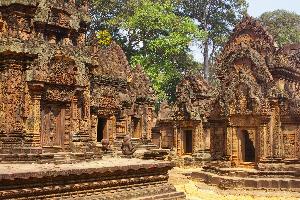
"Gingerbread" Buildings
It seems like every square inch of these buildings is engraved either with great mythological scenes, or exquisite patterns.
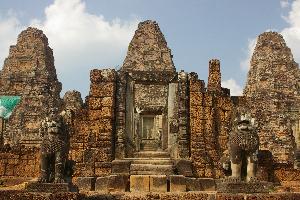
Eastern Mebon
On the way back from Banteay Srei we stopped at this ruin, that of Eastern Mebon. This place is a funerary vault, holding the ashes of kings, which were incinerated at the crematorium complex of Pre Rup.
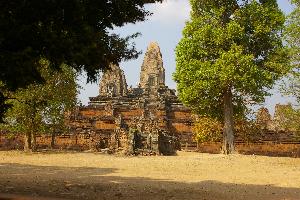
Pre Rup
A few kilometers to the south of Eastern Mebon is Pre Rup, which as I said, was essentially a crematorium.
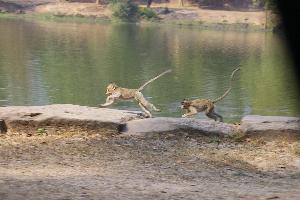
Racing Monkeys
Along the south edge of Angkor Wat proper, two monkeys play tag.
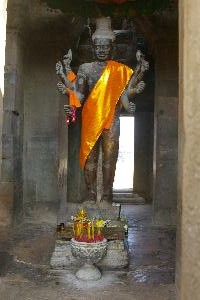
Eight Arms
This statue in one of the side entrances of Angkor Wat's outer perimeters recently had its head restored.
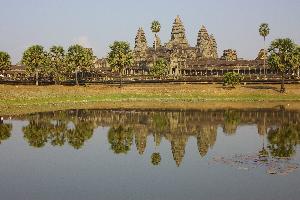
Angkor Wat at Last
After having spent several days skirting the central feature of this site, we now delve in. Here we see it from beyond a small pond, all that remains after the end of the dry winter season.
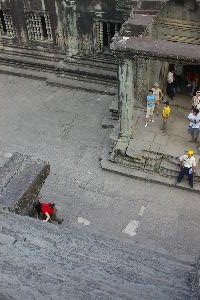
Not ADA Compliant
The first thing you notice about almost all of the stairs here is that they are very steep -- a 6-inch tread with as much as an 18 inch rise, so when you climb stairs here, you really climb!
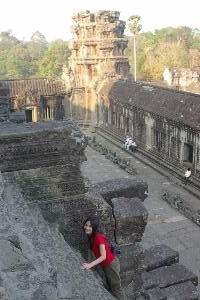
Stairway to Heaven
There's a purpose to such steep ascents, I'm told (aside from allowing very tall buildings...) -- the summit of Angkor Wat represents heaven, and it is a journey you are supposed to work at. Y'know, the view from heaven isn't that bad.... ;)
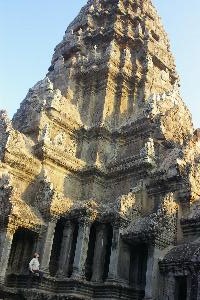
Inner Sanctum
Here we look at the central cupola of Angkor Wat, looking up from beneath the cupola at north-west corner of the courtyard. The sun is getting low in the sky, so the lighting is quite dramatic.
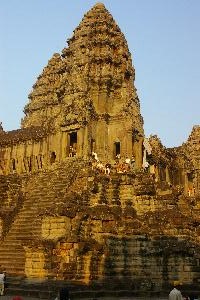
p2030690.jpg
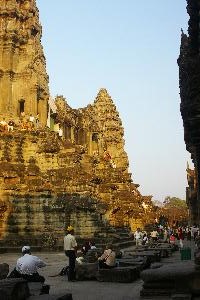
Steep Descent
Here's just another view of the slope pilgrims must ascend (and later descend) when visiting the summit...
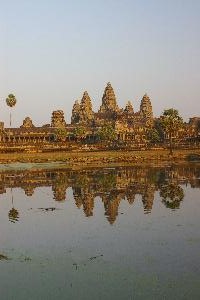
Last Golden Light
As the sun approaches the horizon, the inner complex is seen, again from beyond one of the diminished ponds. The air is still, and still quite hot. Frogs in the pond cause the only disturbance to the reflection.
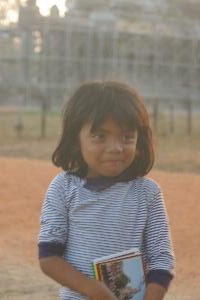
Buy Postcard! Ten for One Dollar!
The first thing you'll encounter when visiting any site here is the knot children relentlessly selling postcards (10 for a dollar is the going rate, but can be negotiated down) and pirated copies of tour books (like Lonely Planet) for a few dollars. As cute as the urchins are, I'm faced with an ethical dilemma of supporting piracy vs. doing the compassionate thing. My recommendation: don't buy, give them school supplies, like paper and pencils.
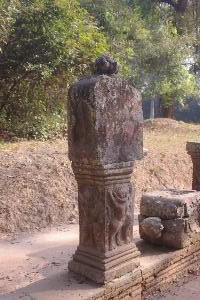
Defaced
The expression "defacing" never really sunk in until I saw this. The history of Angkor Wat spans many centuries, with many changes in religious sensibilities. Prea Khan, when built, had many depictions of Buddha, but subsequently Hindu faithful removed all such traces (all but one, see below!) and in some cases altered the original carving to depict hindu deities.
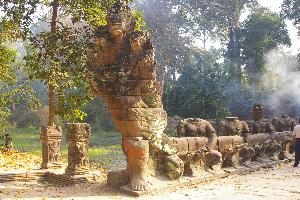
Beheaded
The supporters of the naga (snake) figure that flanks this bridge suffered a similar fate. It wasn't clear whether this was hindu vandalism or merely a change in the religion over the centuries, but one thing is clear: hundreds, possibly thousands, of Buddha depictions are now gone.
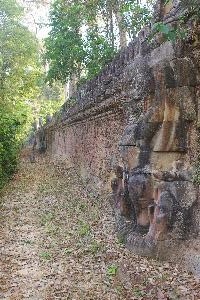
Guardians
Every hundred meters or so, these guardians discourage intruders. Note that the tooth-like structures at the top of the wall each had a depiction of Buddha, but each one has been removed.
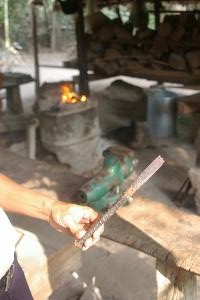
Stoneworking Tools
Take a bit of rebar, shape and temper it, and you've got a chisel good enough for the restoration efforts here...
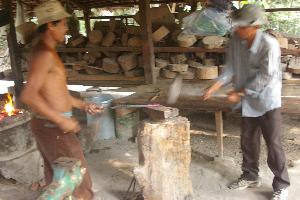
Jingle-bang-jingle
The familiar sound of a blacksmith forging the next tool can be heard here just inside the western gate of Prea Khan.
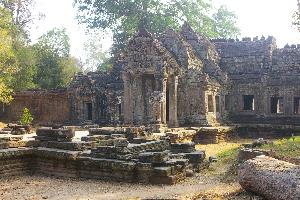
Inner Gate
Down a short path through jungle that has found its way into the site, and you come to this gate.
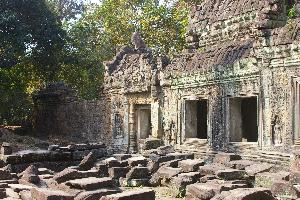
Inner Ruins
Just inside that building, the courtyard lays strewn with remains of a fallen structure.
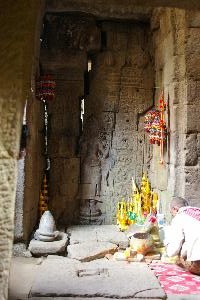
Secluded Shrine
If you venture off the main path that leads east/west down the middle of the site, you find this shrine hidden in a small alcove. Faithful come here to pray.
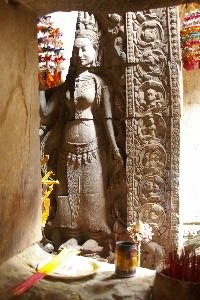
Hidden Shrine
If you're willing to squeeze through a tiny passage, you can make it to this shrine, too. But be warned, it's really cramped here.
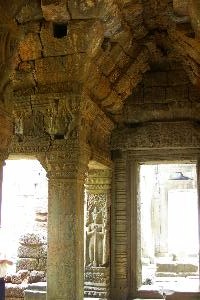
Pillars and Vaults
The inner sandstone has fallen away, revealing the laterite "skeleton" that makes up the foundation and structural composition of most buildings in Angkor Wat.
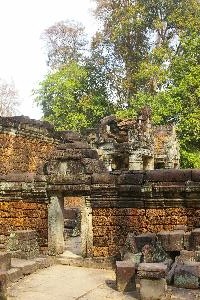
Colors
The wall here shows the iron-rich laterite, and the pale dusty sandstone that the forms the door frames. The lintel and wall caps are also sandstone, but covered in thick lichens.
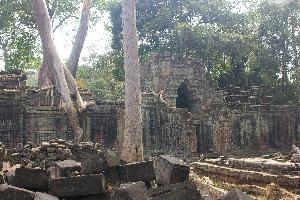
Jungle Intrusion
Like Ta Prohm, this site is fairly close to its rediscovered state... some restoration has taken place, but here too some trees have become so invasive that it's next to impossible to remove... and even if you could, some of the drama and charm would be gone.
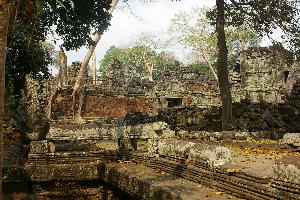
Low Walls
Restoration efforts haven't begun in earnest at Prea Khan, giving it, like Ta Prohm, still very much that storybook "lost world" charm.
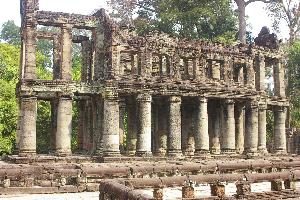
The King's Sword
This ruin is where the king's sacred sword was kept, and the structure here is the building in which it was stored.
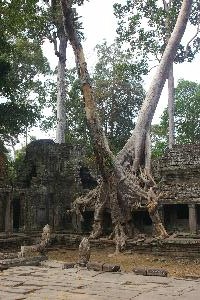
Two Trees
Here not one but two trees once clung tenaciously to, and now essentially support, the loggia of this structure.
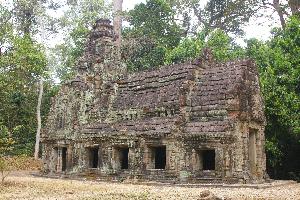
Library
A bit to the east, one of two small libraries sits on either side of the path to the eastern gate.
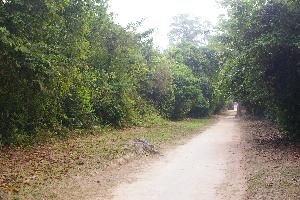
Jungle Reclaimed
When built, this area was thought to have been completely cleared, such that the eastern gate (barely visible in photo) and wall would have been the defining boundary of the place.
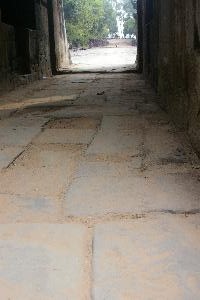
Recent War Strife
Scars on the stone from tanks passing through this gate are visible. Nearby, sections of wall are riddled with bullet holes.
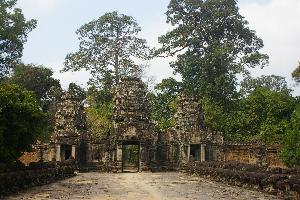
East Gate
An almost mirror image of the western gate (above) is seen here. The heads of the supporting gods and demons were long ago removed, and again, the images of the Buddha were likewise chipped away...
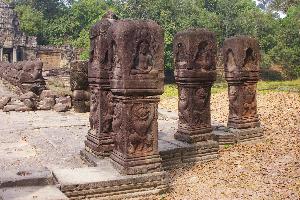
All But One
...all but one, that is. Interestingly, one single carving remains, either overlooked or spared by the vandals of history.
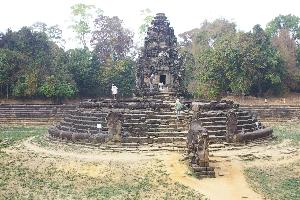
Temple of Healing
Just a bit east of Prea Khan is Neak Pean, a temple of healing which has been partially reclaimed from the jungle.
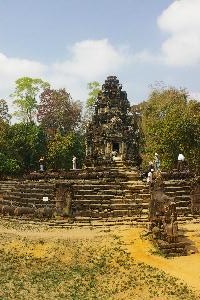
Pools of Holy Water
A large central pool, shown here, and four satellite pits, produced purified holy water used in healing rituals.
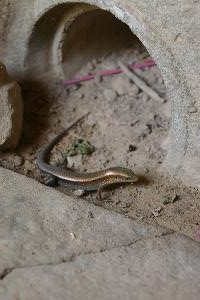
Pools are Dry
Presently, the pools are dry (during the rainy season, they fill up.) For now, however, local life makes use of the refuge the structures provide.
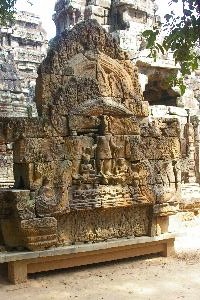
Ta Som Restoration
Restoration is afoot at the small site of Ta Som found just a little bit farther down the grand circuit.
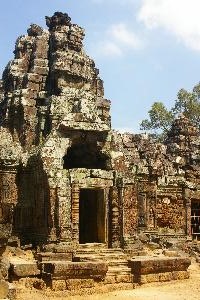
p2040860.jpg
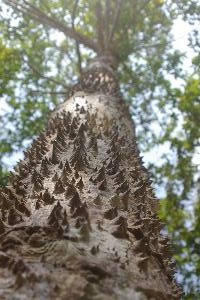
Sharp Tree
The south-eastern panel of Angkor Wat depicts punishments for wrong doers, including the sin of adultery (for both men and women, interestingly.) The unfaithful can expect to be tied to and embrace a jagged-spiked tree for all eternity for their transgression. Here's one specimen of such a tree....
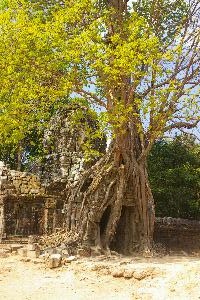
Eastern Gate
At the eastern edge of Ta Som, a single lonely gate, adorned with its own tree, looks out over a path that goes nowhere.
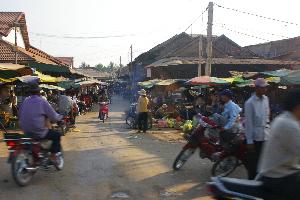
Street Market
Back in Siem Reap, we pass by an open market bustling with activity.
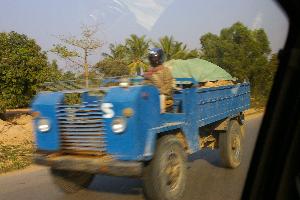
Headless Truck
There are many strange vehicles on the road in Cambodia, including this fairly common specimen, a dump-truck of sorts without a cab or even windshield. The drivers are often seen wearing full motorcycle helmets.
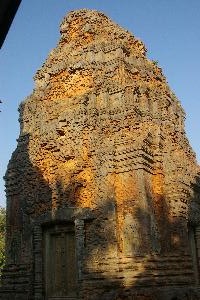
Lolei Sunset
Several kilometers east of Siem Reap are a handful of structures that represent the predecessors to Angkor Wat. One of them, Lolei, is shown here. Though being restored, it is little more than a handful of cupolas.
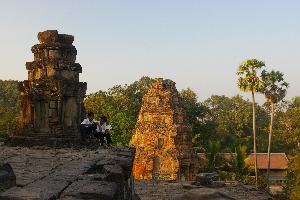
Bakong Sunset
Being so far from the "beaten tracks", the Bakong is far less touristy, and an ideal place to serenely watch the sun set without the choking dust and fumes of tour busses and the constant din of hundreds of tourists. It's what Angkor Wat used to be.
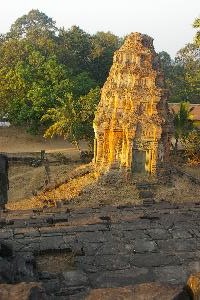
p2040932.jpg
It's also situated in the middle of a village, so you can sit atop the summit and watch life go by all around you. So in a way, it's the perfect way to cap off a stay at Angkor Wat.
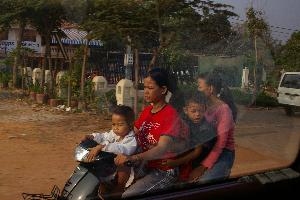
Mass Transit
Okay, in the US, a scooter is seen as as single-person transport, and sometimes a second person hops on for a ride. But here it is not uncommon to see three, four, or in this case, five people riding one of these two-wheelers.
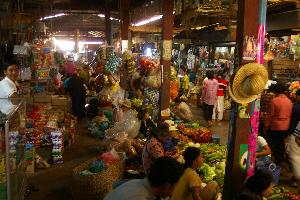
Inside the Market
The tourists seldom delve any deeper than the shops facing the street, but this market fills the entire block. While it caters mainly to the locals, it's got literally everything.
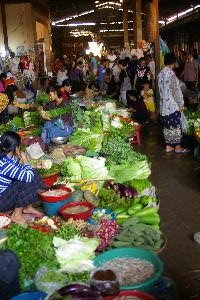
More Food than Safeway
It may be hard to believe, but there's a wider selection of food here than in most supermarkets in the US. I dare you to find half this stuff in your local Safeway.
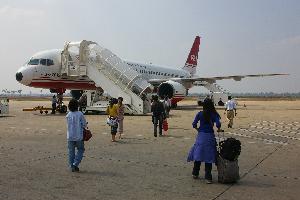
Da Plane!
Well, after several hours delay, it's finally time to board, and say "Good Bye" to Siem Reap and the Angkor Wat complex. Though the place has been overrun with tourists, I have to say that it's been fun.
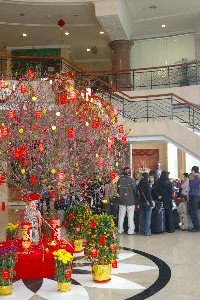
Further Delay
In mid-air, we got an announcement that continuing fog over Taipei prevented our flight from landing, so we were diverted to Macau, where we were put up for the night. A bit of a disappointment, since it threw the rest of the travel plans into disarray, but it beat the alternatives.
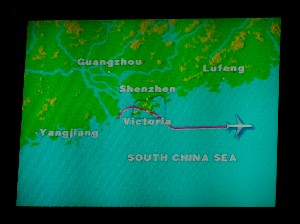
Strange Airspace Rules
The diversion happened to be during the historic agreement between China and Taiwan, where "direct" flights were allowed. Previously, travelers going from one place to the other had to fly to a third desitantion (typically Hong Kong,) deplane, and get on another flight, usually adding 3-4 hours to a trip that's typically only 100 miles. Now, for a window between January 29 and February 20, "direct" flights are allowed between the mainland and the island, provided that the plane flies through Hong Kong or Macau airspace. Hmmm... but we took off from Macau airspace. Why the jog over Hong Kong? I guess the pilot was being extra careful with this unscheduled flight.